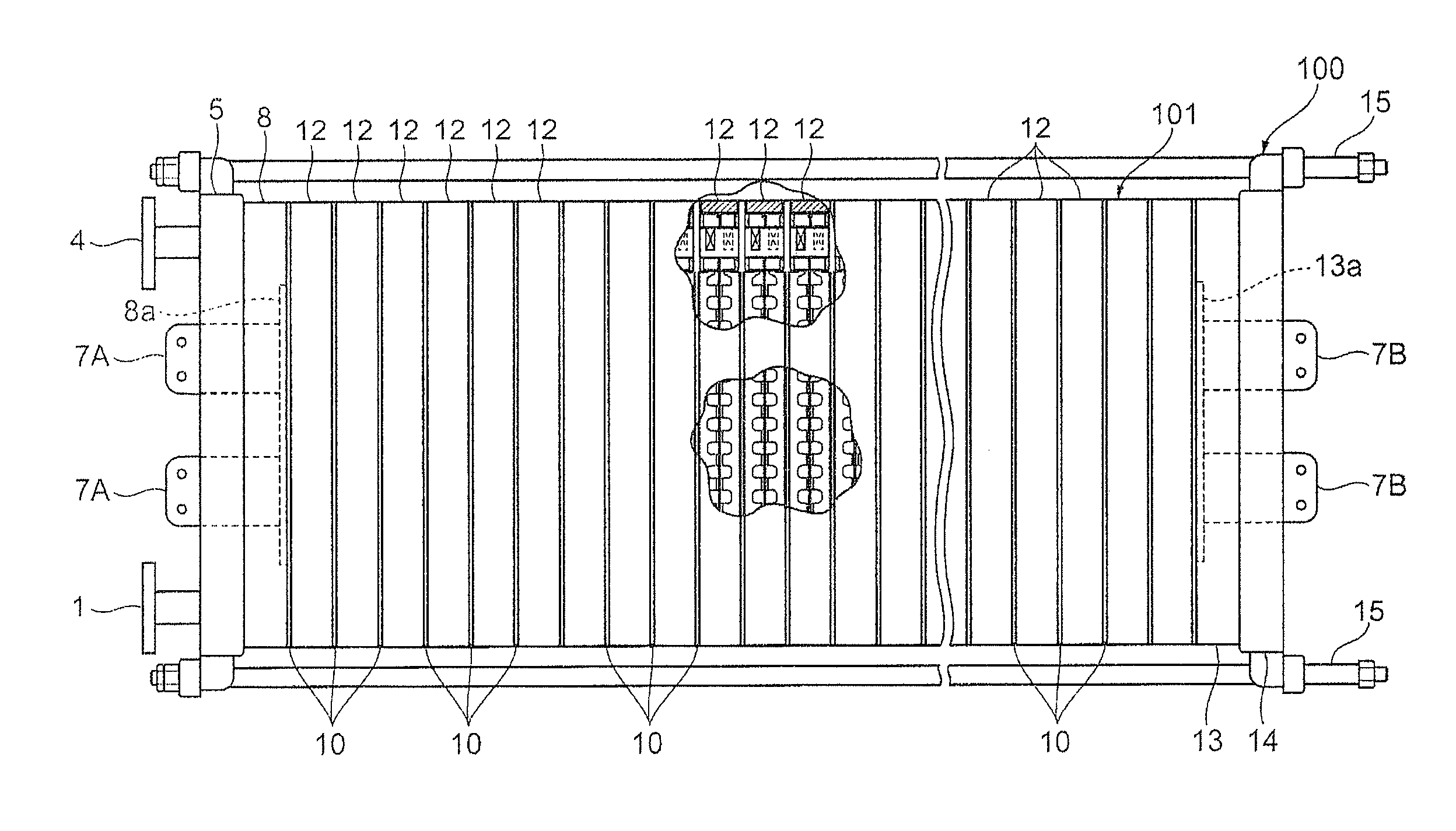Bipolar alkaline water electrolysis unit and electrolytic cell
a technology of bipolar alkaline water and electrolysis cell, which is applied in the direction of electrolysis components, electrolysis processes, electrolysis coatings, etc., can solve the problems of high energy consumption, inability to put to practical use, and difficulty in producing a large electrolysis cell, so as to achieve convenient assembly and maintain the effect of facility costs
- Summary
- Abstract
- Description
- Claims
- Application Information
AI Technical Summary
Benefits of technology
Problems solved by technology
Method used
Image
Examples
example 1
[0221]An electrolytic cell 100 similar to the one depicted in FIG. 2 was assembled by using three cells with electrolysis units 12 similar to those according to the first embodiment depicted in FIG. 3 and FIG. 4, and placing the press flange 5, the press flange gasket 6, and the anode terminal unit 8 at one end of the electrolytic cell, while arranging the end press flange 14 with the cathode terminal unit 13 and the insulating plate 41 attached thereto, at the other end, as depicted in FIG. 1.
[0222]The electrolysis unit 12 was shaped like a circle with an outer diameter of 700 mm, and the areas of the anode 18 and the cathode 19 were each 0.25 m2. Furthermore, the depth (anode chamber depth) of the anode chamber 103 was 15 mm, and the depth (cathode chamber depth) of the cathode chamber 105 was 15 mm. The materials for the anode side flange pan 23 and the cathode side flange pan 24 were each nickel. The nickel partition wall 22 to which the nickel anode rib 20 of height 15 mm and t...
example 3
[0234]An electrolytic cell 100 similar to the one depicted in FIG. 2 was assembled by using three cells with electrolysis units 120 similar to those according to the second embodiment depicted in FIGS. 8 to 10 instead of the electrolysis units 12, and placing the press flange 5, the press flange gasket 6, and the anode terminal unit 8 at one end of the electrolytic cell, while arranging the end press flange 14 with the cathode terminal unit 13 and the insulating plate 41 attached thereto, at the other end, as depicted in FIG. 1.
[0235]The electrolysis unit 12 was shaped like a circle with an outer diameter of 700 mm, and the areas of the anode 18 and the cathode 19 were each 0.25 m2. Furthermore, the depth (anode chamber depth) of the anode chamber 103 was 15 mm, and the depth (cathode chamber depth) of the cathode chamber 105 was 15 mm. The materials for the anode side flange pan 23 and the cathode side flange pan 24 were each nickel. The partition wall 22 to which the nickel anode ...
example 4
[0242]An electrolytic cell 100 similar to the one depicted in FIG. 2 was assembled by using three cells with electrolysis units 120 similar to those according to the fourth embodiment depicted in FIG. 9, FIG. 16, and FIG. 10 instead of the electrolysis units 12, and placing the press flange 5, the press flange gasket 6, and the anode terminal unit 8 at one end of the electrolytic cell, while arranging the end press flange 14 with the cathode terminal unit 13 and the insulating plate 41 attached thereto, at the other end, as depicted in FIG. 1.
[0243]The electrolysis unit 120 was shaped like a circle with an outer diameter of 700 mm, and the areas of the anode 18 and the cathode 19 were each 0.25 m2. Furthermore, the depth (anode chamber depth) of the anode chamber 103 was 15 mm, and the depth (cathode chamber depth) of the cathode chamber 105 was 15 mm. The nickel anode rib 20 of height 15 mm and thickness 1.5 mm and the nickel cathode rib 21 of height 13.5 mm and thickness 1.5 mm we...
PUM
| Property | Measurement | Unit |
|---|---|---|
| Temperature | aaaaa | aaaaa |
| Length | aaaaa | aaaaa |
| Fraction | aaaaa | aaaaa |
Abstract
Description
Claims
Application Information
 Login to View More
Login to View More - R&D
- Intellectual Property
- Life Sciences
- Materials
- Tech Scout
- Unparalleled Data Quality
- Higher Quality Content
- 60% Fewer Hallucinations
Browse by: Latest US Patents, China's latest patents, Technical Efficacy Thesaurus, Application Domain, Technology Topic, Popular Technical Reports.
© 2025 PatSnap. All rights reserved.Legal|Privacy policy|Modern Slavery Act Transparency Statement|Sitemap|About US| Contact US: help@patsnap.com



